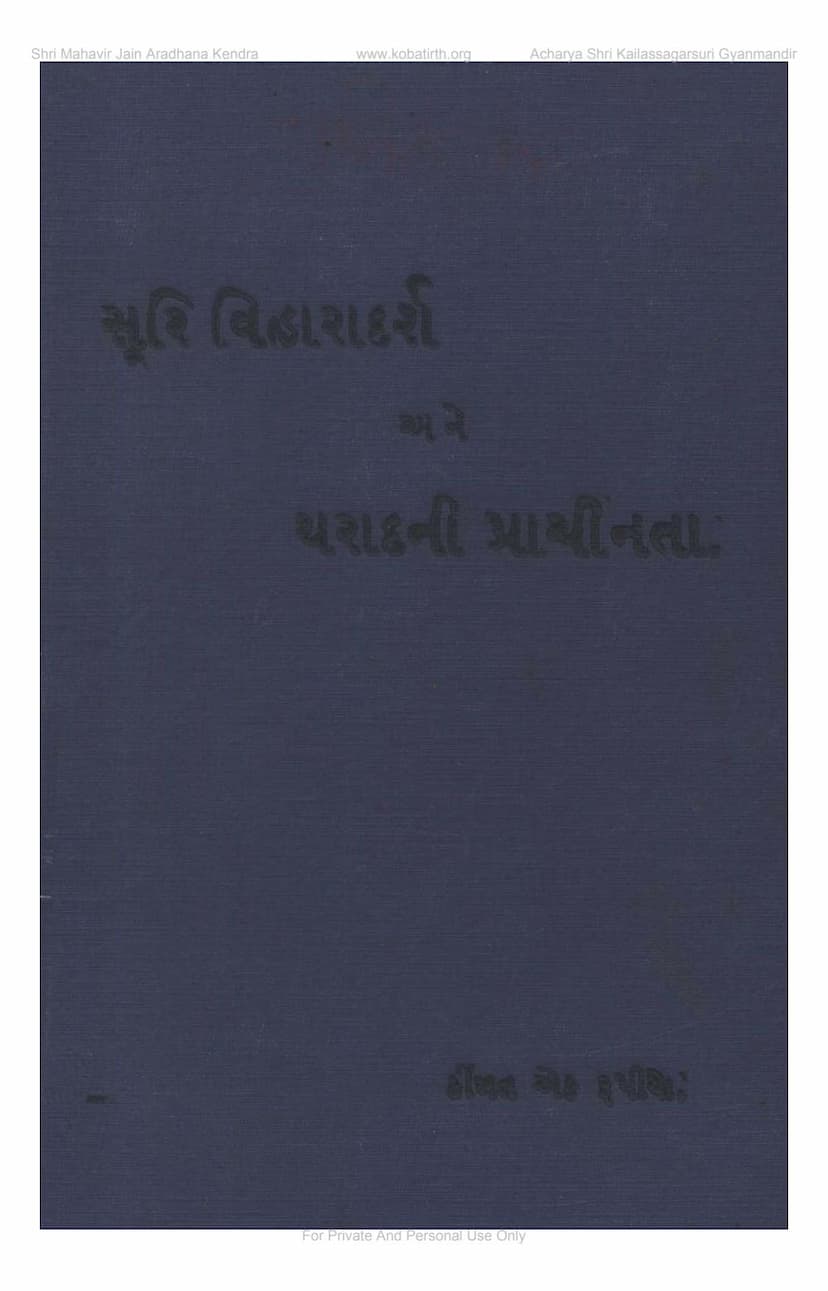Suri Viharadarsh Ane Tharadni Prachinta
Added to library: September 2, 2025

Summary
Here's a comprehensive summary of the Jain text "Suri Viharadarsh Ane Tharadni Prachinta" (Suri's Travelogue and the Antiquity of Tharad) by Hansvijay, published by Rajendra Jain Seva Samaj:
This book is a detailed account of the religious journeys (vihars) of Acharya Shri Vijaybhuopenidrasurishwarji Maharaj and his monastic entourage, and simultaneously delves into the historical and religious significance of Tharad (also referred to as Thirthpur).
Part 1: Suri Viharadarsh (Suri's Travelogue)
The first part of the book meticulously chronicles the extensive travels of Acharya Shri Vijaybhuopenidrasurishwarji Maharaj and his disciples. The narrative begins with their departure from Ratlam, Malwa region, in Vikram Samvat 1981 (1926 CE).
Key highlights of the travelogue include:
- Extensive Pilgrimage: The Acharya and his disciples visited numerous prominent Jain pilgrimage sites, including Palitana (Shatrunjay), Talaja, Ghogha, Bhavnagar, Vartaj, Girnar, Veraval, Prabhas Patan, Junagadh, Ahmedabad, Patan, Sansheshwar, Taranga, Bhiladiya, Mandavgadh, Kesariya, Abu, Kumbhariya, and many others across Gujarat, Saurashtra, and other regions.
- Religious Activities: During their travels, they engaged in various religious activities such as:
- Chaturmas: Observing the four-month monastic retreat in various cities like Palitana and Tharad.
- Pratishthas: Participating in the consecration ceremonies of new Jain temples and installation of deities.
- Upadhan Taps: Conducting and participating in significant fasting rituals.
- Vyakhyans (Sermons): Delivering insightful discourses on Jain philosophy, ethics, and scriptures to large congregations.
- Educational Initiatives: Inspecting Jain schools, libraries, and other religious institutions, and often establishing new ones. They also conducted examinations for students.
- Spiritual Guidance: Providing spiritual guidance, encouraging adherence to Jain principles like Ahimsa (non-violence), Tapasya (austerity), and proper conduct.
- Community Engagement: Interacting with Jain communities, addressing their concerns, and inspiring them towards greater religious devotion and social service.
- Specific Events: The book highlights significant events like the completion of the monumental "Abhidhan Rajendra Kosh" compilation, which was a massive undertaking involving immense effort and scholarly contribution. The Acharya's role in this endeavor and his devotion to his Guru are emphasized.
- Detailed Route: The travelogue provides a day-by-day or city-by-city account of their journey, mentioning the specific dates of arrival, stay duration, and significant events or activities in each place. The book lists towns and cities visited in sequence, painting a vivid picture of the Acharya's vast itinerary.
Part 2: Tharadni Prachinta (The Antiquity of Tharad)
This section focuses on the historical and religious background of Tharad, a significant city in the Banas Kantha region.
Key aspects covered include:
- Origin of Tharad: The book traces the history of Tharad's founding to Vikram Samvat 101 (45 CE) by Chauhan Rajput Tharpaal Dhara. It explains how the city was named 'Thirpur' after the deity associated with Tharpaal Dhara and later became known as Tharad. The narrative includes a fascinating legend about the establishment of the 'Naanu Devi' (Aashapuri Mataji) temple and the subsequent foundation of the city based on divine instructions.
- Historical Rulers and Dynasties: The text details the succession of rulers and dynasties that governed Tharad, including the Parmars, Chauhans, Muslims (Moltani rule), and various Rajput clans like the Vaghelas, Sodhis, and ultimately the ruling Thakore family of Tharad. It sheds light on periods of prosperity, decline, conquests, and administrative changes in the region.
- Jain Heritage of Tharad: The book emphasizes Tharad's rich Jain past, mentioning:
- Ancient Jain Temples: Descriptions of numerous Jain temples, some dating back centuries, with details about their construction, deities, and historical inscriptions. It notes the presence of impressive idols and mentions idols being unearthed from historical sites.
- Jain Population and Institutions: Information about the historical Jain population in Tharad, the establishment of Jain schools (Pathshalas), libraries, and community organizations like the "Shri Rajendra Jain Seva Samaj" and "Shri Dhanachandra Suri Jain Pathshala."
- Jain Bhandars: Mentions of ancient Jain manuscript libraries, highlighting the preservation of Jain scriptures and literature.
- Community Devotion: The text praises the deep religious devotion of the Jain community in Tharad and surrounding areas, their efforts in maintaining and renovating temples, and their contributions to religious activities.
- Social and Economic Aspects: The book touches upon the economic conditions, trade routes, and social fabric of Tharad and its surrounding regions throughout history, including periods of drought and migration.
- Royal Patronage: It highlights the influence and patronage of Jainism by various rulers, including Maharaja Kumarpal and subsequent rulers, who supported the construction and maintenance of Jain temples and institutions.
- Jain Sects and Traditions: Brief mentions of different Jain traditions or sub-sects, like the 'Kad Panth-mat', are also included.
- Literary Contributions: The book itself is a testament to the compilation of historical and religious information, drawing from ancient texts, oral traditions, and contributions from various individuals.
Overall Significance:
"Suri Viharadarsh Ane Tharadni Prachinta" serves as a valuable historical and religious document. It not only provides a comprehensive record of Acharya Shri Vijaybhuopenidrasurishwarji Maharaj's spiritual journey but also offers a detailed glimpse into the historical evolution and enduring Jain heritage of Tharad. The book is a rich repository of information for scholars, researchers, and devotees interested in Jain history, pilgrimage traditions, and the cultural landscape of the region. It also serves as a tribute to the significant contributions of Jain Acharyas and the Jain community in preserving and promoting their faith and heritage.